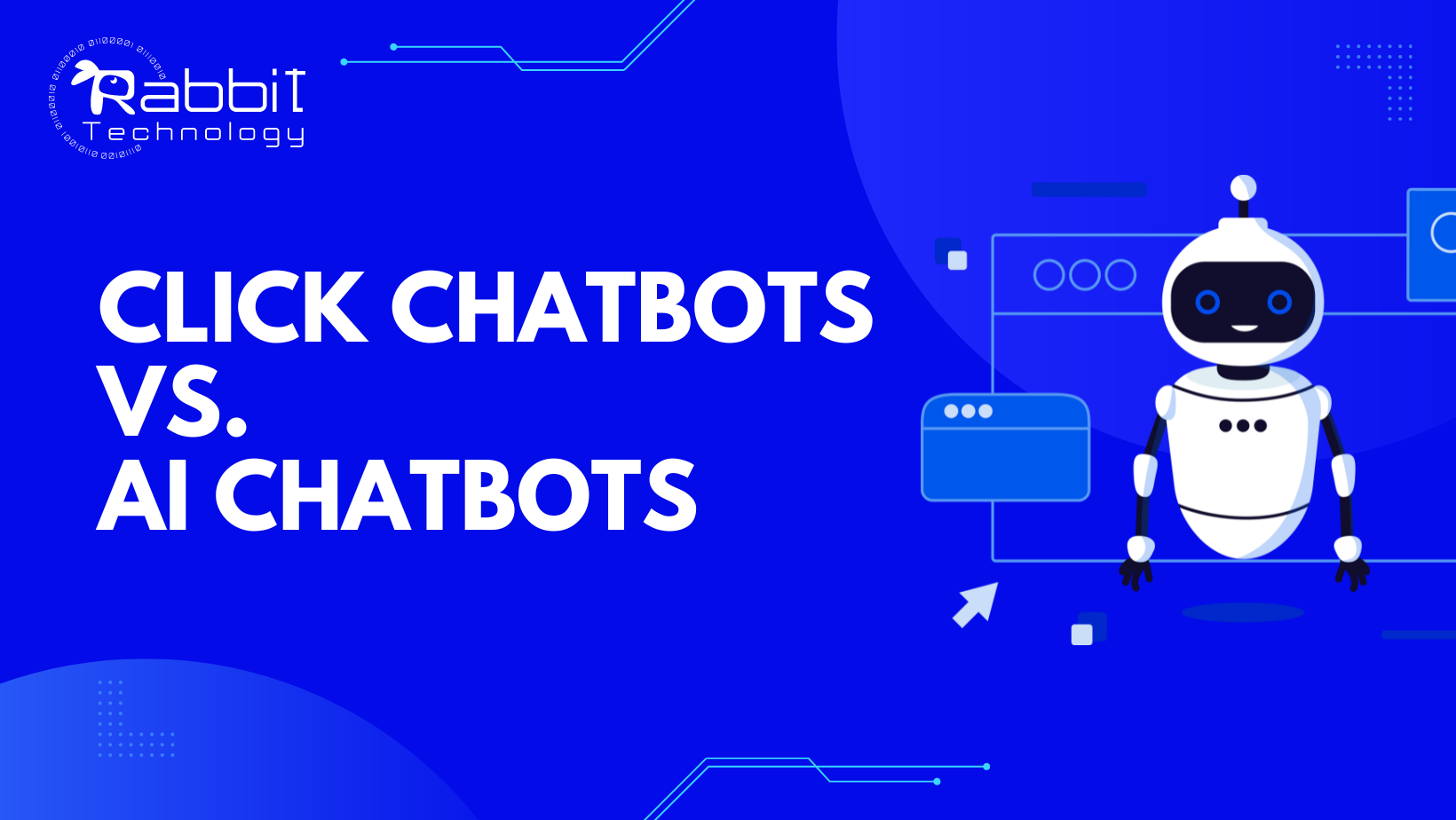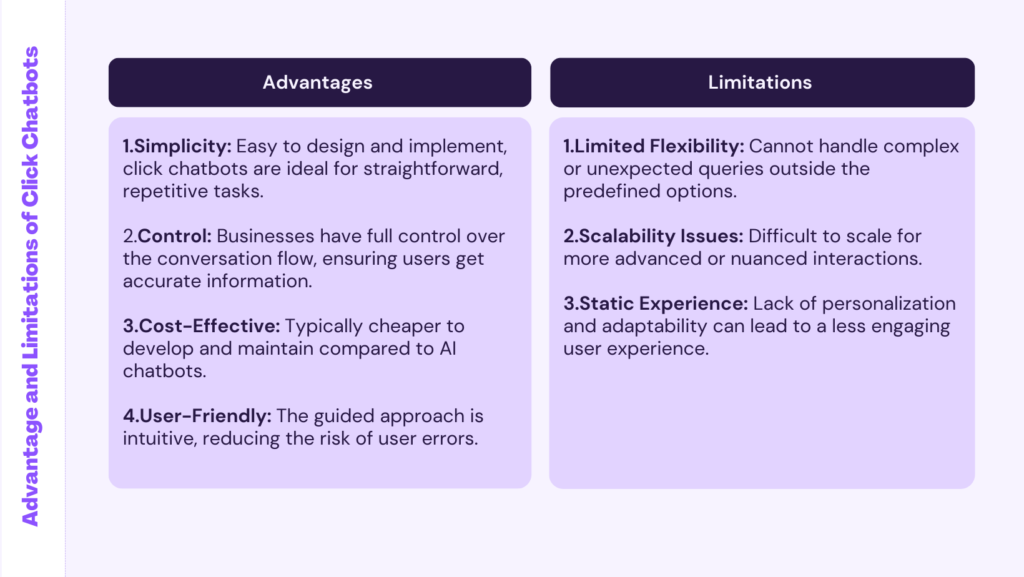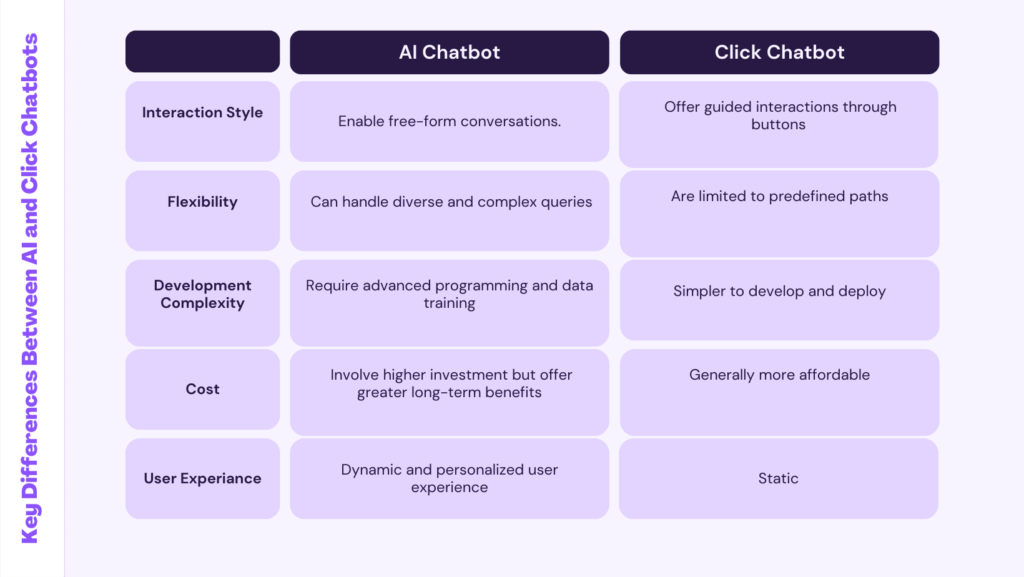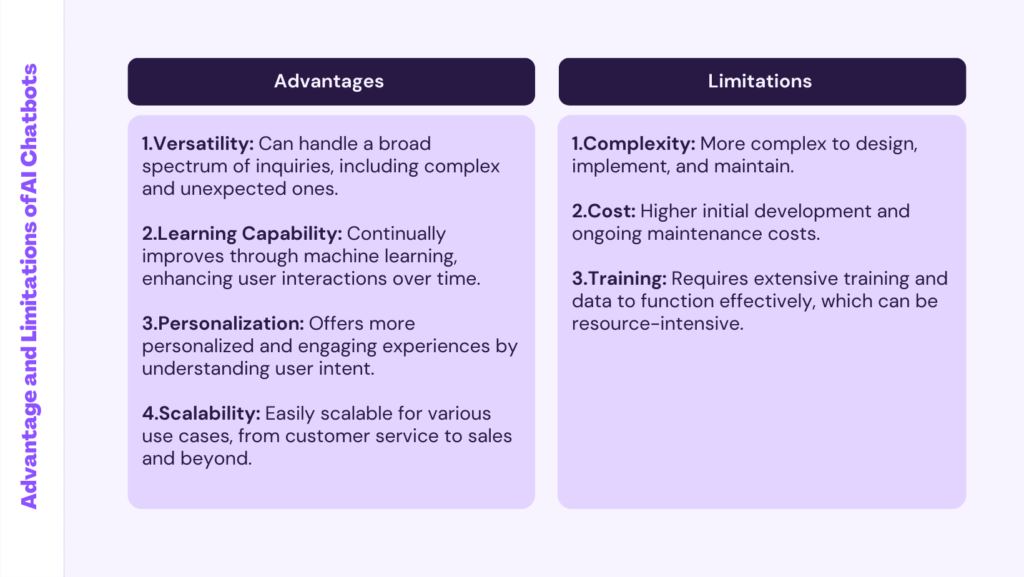
Chatbots have become a cornerstone of customer service in today’s digital landscape, providing quick and efficient interactions. However, They are not all created equal. Significant differences exist between AI chatbots and click chatbots, each with strengths and weaknesses. This blog will delve into the distinctions between these two types, helping you understand which might be the best fit for your business needs. Before we start let us have a walk through the chatbot history
A Brief History of Chatbots: From Early Experiments to Modern Marvels:
The Birth of Chatbots (1950s & 1960s)
From Early Mimics to Modern Marvels, In the bygone era of the 1950s and 1960s, amidst the whirring of machines and the glow of giant computers, a curious invention emerged. It wasn’t a robot with flashing lights, but a program that could hold a conversation, of sorts. This pioneer was called ELIZA, a software therapist designed by Joseph Weizenbaum.
ELIZA wasn’t your typical doctor. It didn’t have a medical degree, but it could mimic a Rogerian therapist, using keywords and clever sentence structures to make you feel heard. Though not truly intelligent, it surprised many with its ability to hold a (somewhat repetitive) conversation.
Soon after, another character entered the scene: PARRY, a fellow chatbot created by Kenneth Colby. PARRY, however, wasn’t there to offer emotional support. It was programmed to simulate a paranoid patient, using similar techniques to ELIZA but aiming to trigger more intense responses. Imagine a conversation with a very suspicious character – that was PARRY!
Expanding Capabilities (1970s & 1980s)
The 1970s saw a shift towards more complex interactions. SHRDLU, a creation of Terry Winograd, could understand and respond to questions about a virtual world filled with colored blocks. It wasn’t exactly the real world, but it marked a significant step towards chatbots engaging with limited environments.
Meanwhile, Jabberwacky, a pioneer in voice interaction, emerged in the 1980s. Unlike its predecessors, Jabberwacky aimed for a lighter touch, offering a playful and entertaining conversation instead of therapy sessions or virtual block parties. Think of it as the fun uncle of the early chatbot world.
The Rise of the Internet (1990s)
As the internet boomed in the 1990s, chatbots found a new home in messaging platforms like AOL Instant Messenger. These digital companions could answer basic questions or provide a bit of fun, like a virtual friend you could chat with online.
Around the same time, click chatbots rose to prominence. Imagine a helpful librarian at a website – that’s the essence of a click chatbot. These menu-driven bots offered a structured way to navigate information or complete tasks, making them efficient assistants in the digital realm.
The AI Revolution (2010s)
But that’s just the beginning of the story! The 2010s witnessed a revolution with the rise of Artificial Intelligence. Natural Language Processing (NLP) and machine learning algorithms were the magic ingredients that transformed chatbots into something truly special. Now, AI chatbots like LaMDA and BlenderBot can understand natural language, hold complex conversations, and even personalize experiences.
A Glimpse into the Future
The potential for chatbots in the future is limitless. As AI continues to evolve, these digital companions will likely become even more sophisticated, seamlessly integrating into our lives and transforming how we communicate across all sorts of fields. Who knows, maybe one day you’ll have a conversation with a chatbot that feels as natural as talking to a friend!
What Are Click Chatbots?
Click chatbots, also called menu-driven chatbots, are a handy tool to automate communication and simplify tasks. They work with pre-made rules, guiding users through a conversation with buttons to choose from. These buttons lead users down specific paths to answer their questions or help them complete tasks.
This makes them a good choice for businesses that want a cost-effective solution, without needing complicated computer programs or fancy language skills. While click chatbots can’t handle super complex conversations like some other chatbots, they have several benefits.
Businesses have complete control over what the chatbot says, they’re cheap to build and maintain, and they’re easy for users to understand. Let’s explore what makes these click-driven assistants tick!
Core Functionalities:
- Structured Navigation: Guide users through a predetermined flow of questions and answers presented as buttons or menus. This makes them ideal for tasks like scheduling appointments, placing orders, or accessing FAQs.
- Task Automation: Users can complete common tasks through the chatbot, freeing up human agents for more complex inquiries. Imagine a click chatbot handling appointment rescheduling or order tracking, saving both time and resources.
- Information Dissemination: Are excellent for providing readily available information. They can act as a virtual knowledge base, offering clear and concise answers to frequently asked questions.
- Lead Generation: Can qualify leads by asking a series of pre-determined questions. This helps businesses identify potential customers and connect them with the appropriate sales representative.
Underlying Technologies:
- Decision Trees: These are flowcharts that map out the conversation based on user choices. Each button click leads the user down a specific branch of the tree, ensuring a smooth and relevant interaction.
- Data Management: Rely on pre-defined data sets containing questions, answers, and corresponding button actions. This data is often stored in a Content Management System (CMS) or a chatbot development platform.
- Integration Capabilities: Can be integrated with various platforms like websites, messaging apps, and CRM systems. This allows for seamless data transfer and a more holistic customer experience.
Benefits of Click-Chatbot:
- User-Friendly: Simple and intuitive interface makes them accessible to users of all technical backgrounds.
- Cost-Effective: Development and maintenance are relatively inexpensive compared to AI chatbots.
- Scalability: Easy to manage and adapt to changing needs by modifying the decision tree and data sets.
- Fast Implementation: Can be deployed quickly, offering a rapid return on investment.
Advantages of Click-Chatbot
- Simplicity: Easy to design and implement, and ideal for straightforward, repetitive tasks.
- Control: Businesses have full control over the conversation flow, ensuring users get accurate information.
- Cost-Effective: Typically cheaper to develop and maintain compared to AI chatbots.
- User-Friendly: The guided approach is intuitive, reducing the risk of user errors.
Limitations of Click-Chatbot
- Limited Flexibility: Cannot handle complex or unexpected queries outside the predefined options.
- Scalability Issues: Difficult to scale for more advanced or nuanced interactions.
- Static Experience: Lack of personalization and adaptability can lead to a less engaging user experience.

Click chatbots may not be the most sophisticated conversationalists, but their strength lies in their straightforward approach. They offer a valuable service by simplifying interactions and making information readily accessible.
What Are AI Chatbots?
Chatbots powered by AI, also called intelligent assistants, use special computer programs to understand natural language and have conversations like a real person. These smart assistants get better at answering your questions the more you chat with them.
Unlike click chatbots with buttons, AI chatbots can have natural back-and-forth conversations, making it feel like you’re talking to a real person.
They can handle tough questions, remember your preferences, and work well in many situations. This makes them ideal for businesses that want to offer top-notch customer service. Let’s look closer at how these AI assistants work!
Core Functionalities:
- Natural Language Processing (NLP): This is the magic sauce that allows AI chatbots to understand the meaning behind user input. By analyzing syntax, semantics, and context, AI chatbots can interpret even complex sentences and respond accordingly.
- Conversation Management: Can track conversation history and user intent. This enables them to maintain a coherent dialogue, reference previous interactions, and adapt their responses for a natural flow.
- Machine Learning: Continuously learn and improve through machine learning algorithms. They analyze vast amounts of conversation data to identify patterns, recognize user preferences, and refine their responses over time.
- Personalization: Can tailor their interactions to individual users. By considering factors like past conversations, demographics, and browsing behavior, they can provide personalized recommendations, support, or product suggestions.
Underlying Technologies:
- Deep Learning: A subset of machine learning, deep learning utilizes artificial neural networks modeled after the human brain. These networks process vast amounts of text data, allowing AI chatbots to recognize complex patterns in language and generate increasingly human-like responses.
- Natural Language Understanding (NLU): This technology focuses on extracting meaning from user input. NLU goes beyond simple keyword recognition, enabling AI chatbots to understand the intent behind a question, the sentiment expressed, and even sarcasm or humor.
- Natural Language Generation (NLG): Once the chatbot understands the user’s intent, NLG comes into play. This technology allows the chatbot to formulate a coherent and natural response, considering factors like tone, context, and the user’s emotional state.
- Large Language Models (LLMs): These are powerful AI models trained on massive datasets of text and code. LLMs allow AI chatbots to access and process information from various sources, enabling them to provide informative and comprehensive responses to user queries.
Benefits of AI-Chatbots:
- Natural and Engaging Interactions: Can hold conversations that feel more human-like, fostering trust and improving user experience.
- 24/7 Availability: They can provide support or answer questions around the clock, increasing customer satisfaction and efficiency.
- Personalized Customer Service: Can tailor their responses to individual users, creating a more engaging and relevant experience.
- Data Collection and Insights: Can collect valuable data from user interactions, helping businesses understand customer needs and preferences better.
Advantages of AI-Chatbots
- Versatility: Can handle a broad spectrum of inquiries, including complex and unexpected ones.
- Learning Capability: Continually improves through machine learning, enhancing user interactions over time.
- Personalization: Offers more personalized and engaging experiences by understanding user intent.
- Scalability: Easily scalable for various use cases, from customer service to sales and beyond.
Limitations of AI-Chatbot
- Complexity: More complex to design, implement, and maintain.
- Cost: Higher initial development and ongoing maintenance costs.
- Training: Requires extensive training and data to function effectively, which can be resource-intensive.
Key Differences Between AI and Click Chatbots

- Interaction Style: Click chatbots offer guided interactions through buttons, while AI chatbots enable free-form conversations.
- Flexibility: AI chatbots can handle diverse and complex queries; click chatbots are limited to predefined paths.
- Development Complexity: Click chatbots are simpler to develop and deploy, whereas AI chatbots require advanced programming and data training.
- Cost: Click chatbots are generally more affordable, while AI chatbots involve higher investment but offer greater long-term benefits.
- User Experience: AI chatbots provide a more dynamic and personalized user experience compared to the static nature of click chatbots.
After Knowing the difference between AI Chatbots and Click Chatbots, When to Use Each Type
- Click-Chatbot are best suited for:
- Simple, repetitive tasks.
- Scenarios where control over the conversation flow is crucial.
- Businesses with limited budgets and resources.
- Use cases where user interactions are straightforward and don’t require much personalization.
- AI-Chatbot are ideal for:
- Handling complex, varied inquiries.
- Businesses looking to provide personalized and engaging user experiences.
- Scenarios where scalability and continuous improvement are important.
- Companies are willing to invest in advanced technology for long-term benefits.
Conclusion
Choosing a chatbot depends on what your business needs, how complex the conversations will be, and your budget. Click chatbots are simple and affordable, while AI chatbots offer a more natural and flexible experience. Knowing the pros and cons of each will help you pick the best one to improve your customer service. Feel free to contact us to discuss your needs and find the perfect chatbot for your business!
In the ever-evolving world of digital interactions, both types of chatbots have their place. The key is to assess your specific requirements and choose the solution that best meets your needs.
